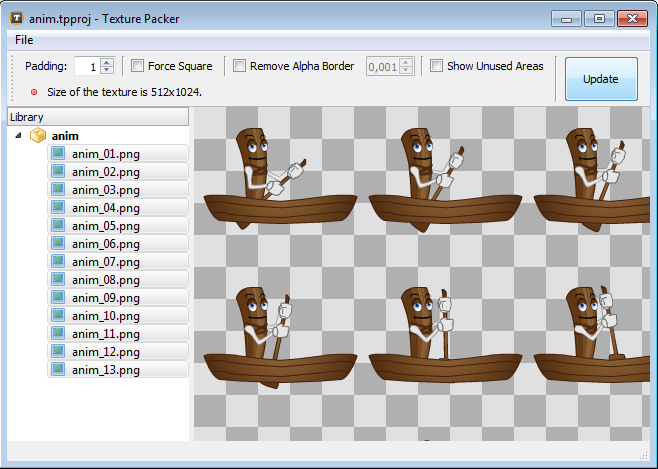Difference between revisions of "TexturePack"
| (36 intermediate revisions by 4 users not shown) | |||
| Line 1: | Line 1: | ||
__NOTOC__ | __NOTOC__ | ||
| − | '''Supported platforms:''' android | + | <!-- GIDEROSOBJ:TexturePack --> |
| + | '''Supported platforms:''' [[File:Platform android.png]][[File:Platform ios.png]][[File:Platform mac.png]][[File:Platform pc.png]][[File:Platform html5.png]][[File:Platform winrt.png]][[File:Platform win32.png]][[File:Platform linux.png]]<br/> | ||
'''Available since:''' Gideros 2011.6<br/> | '''Available since:''' Gideros 2011.6<br/> | ||
| + | '''Inherits from:''' [[TextureBase]]<br/> | ||
| + | |||
=== Description === | === Description === | ||
| − | + | The '''TexturePack''' class specifies a texture pack (or texture atlas). A texture atlas is a large image which contains many smaller sub-images. | |
| − | Gideros supports dynamic creation of texture atlases and pre-packed texture atlasses by using | + | |
| − | + | Gideros supports dynamic creation of texture atlases and pre-packed texture atlasses by using "Gideros Texture Packer" tool. | |
| − | + | ||
| − | + | ==== Dynamic Creation of Texture Packs ==== | |
| − | + | To create a texture pack dynamically (at run-time), create a '''TexturePack''' object with a table of file names of textures. | |
| − | To create a texture pack dynamically (at run-time), create | + | <syntaxhighlight lang="lua"> |
| − | < | + | local pack = TexturePack.new({"1.png", "2.png", "3.png", "4.png"}) |
| − | + | </syntaxhighlight> | |
| − | + | ||
| − | + | Example | |
| − | To create a pre-packed texture atlas, use | + | <syntaxhighlight lang="lua"> |
| − | + | local tp = TexturePack.new({"gfx/2_2.png", "gfx/button01.png", "gfx/button02.png", "gfx/cat.jpg"}) | |
| − | + | local bmp = Bitmap.new(tp:getTextureRegion("gfx/button01.png")) | |
| − | + | stage:addChild(bmp) | |
| − | + | </syntaxhighlight> | |
| − | This tool exports two files: | + | |
| − | Use these two files to create texture pack:< | + | ==== Static Creation of Texture Packs ==== |
| − | + | To create a pre-packed texture atlas, use "Gideros Texture Packer" tool: | |
| + | |||
| + | [[File:Texture packer.png]] | ||
| + | |||
| + | This tool exports two files: a ''.txt'' file that specifies the positions of texture regions and a ''.png'' file of packed texture. | ||
| + | |||
| + | Use these two files to create a texture pack: | ||
| + | <syntaxhighlight lang="lua"> | ||
| + | local pack = TexturePack.new("pack.txt", "pack.png") | ||
| + | </syntaxhighlight> | ||
| + | |||
{|- | {|- | ||
| − | | style="width: 50%;"| | + | | style="width: 50%; vertical-align:top;"| |
=== Methods === | === Methods === | ||
| − | [[TexturePack.new]] - creates a new TexturePack object<br/> | + | [[TexturePack.new]] ''creates a new TexturePack object from textures''<br/><!--GIDEROSMTD:TexturePack.new(textures,padding,filtering,options) creates a new TexturePack object from textures--> |
| − | [[TexturePack.new]] - <br/> | + | [[TexturePack.new]] ''creates a new TexturePack object from texture pack files''<br/><!--GIDEROSMTD:TexturePack.new(txtfile,imagefile,filtering,options) creates a new TexturePack object from texture pack files--> |
| − | [[TexturePack: | + | [[TexturePack.new]] ''creates an open TexturePack based on a RT'' '''''NEW'''''<br/><!--GIDEROSMTD:TexturePack.new(renderTarget) creates an open TexturePack based on a RT--> |
| − | | style="width: 50%;"| | + | [[TexturePack.loadAsync]] ''asynchronously loads a TexturePack object from texture pack files''<br/><!--GIDEROSMTD:TexturePack.loadAsync(callback,txtfile,imagefile,filtering,options) asynchronously loads a TexturePack object from texture pack files--> |
| + | |||
| + | [[TexturePack:getLocation]] ''returns the location of the given texture in this pack''<br/><!--GIDEROSMTD:TexturePack:getLocation(texturename) returns the location of the given texture in this pack--> | ||
| + | [[TexturePack:getRegionsNames]] ''returns all the region names of this pack''<br/><!--GIDEROSMTD:TexturePack:getRegionsNames() returns all the region names of this pack--> | ||
| + | [[TexturePack:getTextureRegion]] ''returns the texture region for the given texture name''<br/><!--GIDEROSMTD:TexturePack:getTextureRegion(texturename) returns the texture region for the given texture name--> | ||
| + | |||
| + | | style="width: 50%; vertical-align:top;"| | ||
| + | |||
=== Events === | === Events === | ||
=== Constants === | === Constants === | ||
|} | |} | ||
| + | |||
| + | {{GIDEROS IMPORTANT LINKS}} | ||
Latest revision as of 22:36, 4 September 2025
Supported platforms: ![]()
![]()
![]()
![]()
![]()
![]()
![]()
![]()
Available since: Gideros 2011.6
Inherits from: TextureBase
Description
The TexturePack class specifies a texture pack (or texture atlas). A texture atlas is a large image which contains many smaller sub-images.
Gideros supports dynamic creation of texture atlases and pre-packed texture atlasses by using "Gideros Texture Packer" tool.
Dynamic Creation of Texture Packs
To create a texture pack dynamically (at run-time), create a TexturePack object with a table of file names of textures.
local pack = TexturePack.new({"1.png", "2.png", "3.png", "4.png"})
Example
local tp = TexturePack.new({"gfx/2_2.png", "gfx/button01.png", "gfx/button02.png", "gfx/cat.jpg"})
local bmp = Bitmap.new(tp:getTextureRegion("gfx/button01.png"))
stage:addChild(bmp)
Static Creation of Texture Packs
To create a pre-packed texture atlas, use "Gideros Texture Packer" tool:
This tool exports two files: a .txt file that specifies the positions of texture regions and a .png file of packed texture.
Use these two files to create a texture pack:
local pack = TexturePack.new("pack.txt", "pack.png")
MethodsTexturePack.new creates a new TexturePack object from textures TexturePack:getLocation returns the location of the given texture in this pack |
EventsConstants |
